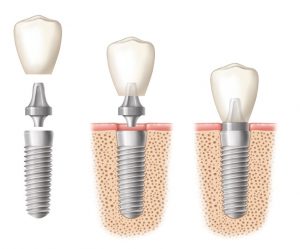Header logo
header top contact widget
Learn More Blog
The Makeup Of Dental Implants
Posted on Jul 10, 2017 by William J. Claiborne, DDS MS
Every once in a while, I find it is helpful to explain the components of Dental Implants. Because implant systems come in many different shapes and sizes, understanding the basics can often help an individual determine which is best suited to his or her overall goals.
For example, some people who have worn a denture for years prefer an implant system that has ‘fixed’ teeth attached. This means they will not need to remove the replacement teeth for cleaning.
First, it’s important to understand that a Dental Implant is not the replacement tooth, but a component that serves as the stablizer. The actual implanted portion is positioned into the jaw to serve as a tooth root replacement. This restores a dependable, sturdy foundation that supports teeth that can bite and chew without movement.
In placing the implant portion, an insertion point is made in the gum tissues and the bone underneath where natural tooth roots were once held. Into this, the implant, which is similar to a hollow screw-like cylinder, is placed.
In most cases, the implants are recovered with gum tissue and allowed to bond with surrounding bone for several months. Throughout this period, you can wear your denture or temporary teeth comfortably.
The process of bone growing around the implant is known as ‘osseo-integration.’ During this time, the bone grows around the implant and secures it in place. After several months, the gum tissue is uncovered and a post is secured inside the implant. Onto this post, the final replacement tooth or teeth are attached. These teeth are referred to as crowns or restorations.
One implant can often support a bridge of two or more teeth. Several strategically-placed implants are often used to support a full arch of teeth. For people who have lost a great deal of bone mass, certain implant systems rely on implants that are placed at specific angles to support teeth in minimal bone depth. However, some levels of bone loss need bone rebuilding procedures. These can be performed prior to implant placement and help restore facial appearance as well as overall eating and speaking function.
Because of the wide variety of implant systems, it is important to carefully choose the doctor who will place your implants. A Periodontist has advanced training in the diagnosis and placement of Dental Implants and works closely with other general dentists and dental specialists to help you enjoy a successful outcome.
The type of Dental Implant best suited for your needs can be discussed during a private Consultation. Call (828) 274-9440to arrange a time to discuss the choices that will work best for you.
Recent Posts
Categories
Archives
- September 2024
- August 2024
- July 2024
- June 2024
- May 2024
- April 2024
- March 2024
- February 2024
- January 2024
- December 2023
- November 2023
- October 2023
- September 2023
- August 2023
- July 2023
- June 2023
- May 2023
- April 2023
- March 2023
- February 2023
- January 2023
- December 2022
- November 2022
- October 2022
- September 2022
- August 2022
- July 2022
- June 2022
- May 2022
- April 2022
- March 2022
- February 2022
- January 2022
- December 2021
- November 2021
- October 2021
- September 2021
- August 2021
- July 2021
- June 2021
- May 2021
- April 2021
- March 2021
- February 2021
- January 2021
- December 2020
- November 2020
- October 2020
- September 2020
- August 2020
- July 2020
- June 2020
- May 2020
- April 2020
- March 2020
- February 2020
- January 2020
- December 2019
- November 2019
- October 2019
- September 2019
- August 2019
- July 2019
- June 2019
- May 2019
- April 2019
- March 2019
- February 2019
- January 2019
- December 2018
- November 2018
- October 2018
- September 2018
- August 2018
- July 2018
- June 2018
- May 2018
- April 2018
- March 2018
- February 2018
- January 2018
- December 2017
- November 2017
- October 2017
- September 2017
- August 2017
- July 2017
- June 2017
- May 2017
- April 2017
- March 2017
- February 2017
- January 2017
- December 2016
- November 2016
- October 2016
- September 2016
- August 2016
- July 2016
- June 2016
- May 2016
- April 2016
- March 2016
- February 2016
- January 2016
- December 2015
- November 2015
- October 2015
- September 2015
- August 2015
- July 2015
- June 2015
- May 2015
- April 2015
- March 2015
- February 2015
- January 2015
- December 2014
- November 2014
- October 2014
- September 2014
- August 2014
- July 2014
- June 2014
- May 2014
- April 2014
- March 2014
- February 2014
- January 2014
- December 2013
- November 2013
- October 2013
- September 2013
- August 2013
- July 2013
- June 2013
- May 2013
- April 2013
- March 2013
- February 2013
- January 2013
- December 2012
- November 2012
- October 2012
- September 2012
- August 2012
- July 2012
- June 2012

